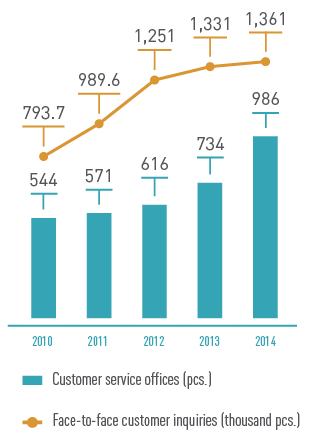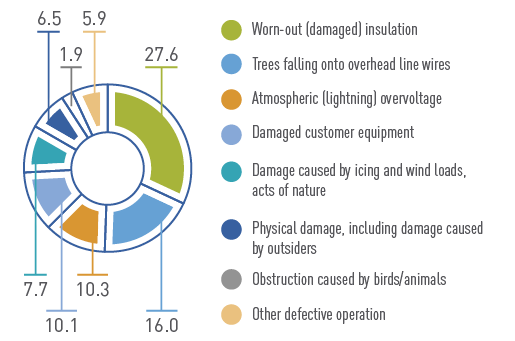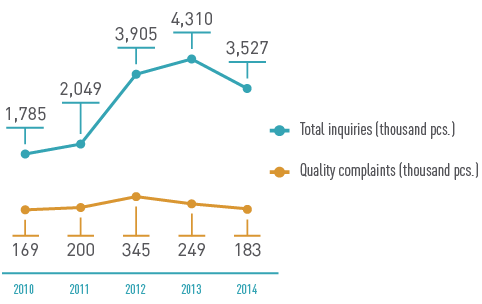Principles of Customer Relations
Customer relations have a direct influence on the financial performance of the ROSSETI Group. With the involvement of the government, public organizations, and other stakeholders, the ROSSETI Group keeps working to balance its interests and the interests of its customers in securing an affordable and reliable electricity supply.
ROSSETI’s social responsibility in the area of customer relations entails understanding how important it is for the Company to act as an infrastructure organization that supports a society and aspiring to play this role as effectively as possible with due regard to the customer’s interests and expectations.
The Company’s high priority is to achieve customer loyalty the ROSSETI Group by providing affordable services, offering high-quality customer service, and ensuring customer satisfaction in the short and long term.
The ROSSETI Group’s Policy on Society, Customer, and Government Relations defines the following guiding principles of customer relations:
- affordable and high-quality services provided by the ROSSETI Group;
- customers’ sufficient awareness of the ROSSETI Group and services;
- territorial accessibility and convenient conditions of the ROSSETI Group’s face-to-face customer service;
- accessibility and promptness of remote and online customer service;
- qualified customer service;
- transparent business processes of the ROSSETI Group’s service performance and customer service.
Customer Service
The Company gives special attention to ensuring that ROSSETI SDCs provide high-quality customer service. Services are provided on a face-to-face basis at the ROSSETI Group’s customer service offices and on a remote basis by telephone and over the Internet.
The ROSSETI Group received 3.5 million inquiries via all customer relations channels in 2014, or 18% less than in 2013. Complaints and requests for advice decreased by 26% and 11.5% respectively. This trend proves the effectiveness of measures taken to improve service quality and that customers are adequately informed.
Opened Offices and Face-to-Face Customer Service
To provide territorial accessibility and convenient conditions for customers, customer service centers are upgraded and fitted with modern equipment such as electronic queue management systems, payment terminals, and self-service information kiosks. Visitors to customer service centers can submit requests for services, including network connection requests, obtain reference information and consultations, make a claim (complaint), and become familiar with information about other local electric utilities.
This work is done by grid organizations in accordance with the Uniform Customer Service Quality Standards approved by the Ministry of Energy of the Russian Federation in 2014.
As at the end of 2014, 986 customer service offices, including 300 customer service centers and 686 customer service points at local divisions of SDCs, operated in the regions served by ROSSETI. Services in the administrative centers of Russian regions are provided by 69 high-standard customer service centers.
In 2014, the Company opened new and upgraded customer service offices in Moscow; Troitsk, New Moscow; Sochi; Sovetsk, Kaliningrad Region; Kashira, Moscow Region; Revda, Sverdlovsk Region; and Anapa, Krasnodar Territory.
The most successful process of developing face-to-face customer service in 2014 was Kubanenergo’s Electronic ROSSETI Project. The project involved opening a customer service center in Sochi, designed to maximally automate customer service processes, including implementing electronic queue management and customer service evaluation systems and using self-service kiosks.
Overall, the number of visitors to ROSSETI customer service offices was 1.36 million in 2014, or 2% more than in 2013. The growth is due to improved territorial accessibility and face-to-face customer service for households in the regions served by the ROSSETI Group.

Customer Service by Telephone and over the Internet
Customer service over the telephone uses call center hotlines and numbers of the operational dispatching units of SDCs. SDCs created hotlines to mitigate the consequences of process failures and promptly provide households with information on the duration of accident recovery work.
The principal goals of a call center is to receive and handle customers’ incoming calls about all issues related to SDCs’ activities and provide a customer with necessary information.
In 2014, the Company received a total of 1.87 million inquiries by telephone. Following current trends, the ROSSETI Group focuses its attention on employing online technology and expanding the use of its uniform customer service website (ПОРТАЛ-ТП.рф) and electronic services on SDCs’ websites. The principal goal of furthering the use of the customer service website is to ensure the accessibility of network connection services by switching over to electronic remote customer service for document management related to customers’ requests to reduce the number of connection stages. SDCs’ websites also offer remote customer service.
The development of remote customer service allowed the Company to double the number of electronic inquiries to 44,700 in 2014.
Results of Surveys Measuring Customer Satisfaction
In order to evaluate customer satisfaction with their core services, ROSSETI SDCs constantly conduct surveys to find how satisfied customers are with service quality and study what customers think about prospects for service development.
The basic approach applied by ROSSETI SDCs is the Customer Satisfaction Index, calculated on the basis of separately evaluated service parameters according to their significance to customers.
In 2014, the ROSSETI Group made more than 100 various surveys, with the number of respondent exceeding 78,000. The surveys typically consisted in questioning visitors to customer service offices and conducting telephone surveys.
The main topic of surveys in the reporting year was the issues of the quality and accessibility of network connection services such as:
- meeting of prescribed network connection deadlines;
- convenience of customer service offices’ location and working hours;
- qualifications and efficiency of personnel;
- ease of obtaining information about the electricity connection procedure.
To have feedback on the development of remote customer service, IDGC of Centre and MOESK conducted an online survey of customer satisfaction with online customer service for receiving network connection requests. The survey collected customer feedback in relation to the further improvement of customer service over the Internet.
The results of the surveys enabled the ROSSETI Group to improve service quality, providing a comfortable environment for customers and increase the transparency of its network connection operations.
The Company will continue to make surveys in the future. It is planned to conduct a survey in 2015 to evaluate the quality and accessibility of network connections in collaboration with OPORA RUSSIA All-Russian Public Organization of Small and Medium Business. The findings will reveal the areas of customer dissatisfaction in the regions where the Company operates and take corrective measures. Therefore, small and medium-sized businesses will be provided with assistance in improving the business environment by enhancing the affordability of the power infrastructure.
Network Connection
Network connection is one of the ROSSETI Group’s main regulated services.
Network connection makes it technically feasible to consume (deliver) electricity (capacity). These services include the actual connection of the following equipment and facilities to networks:
- power-receiving equipment of customers;
- power generation facilities;
- electric grid facilities owned by grid organizations and other persons.
Network Connection Results in 2014
In 2014, the ROSSETI Group continued to systematically provide electricity connections.
|
Indicator |
Number, 2014 |
Changes, 2014/2013, % |
|---|---|---|
|
Network connection requests |
488,324 pcs. |
+2 |
|
Total capacity (under requests) |
52,022 MW |
-5 |
|
Network connection contracts |
383,125 pcs. |
-0.06 |
|
Total capacity (under contracts) |
20,468 MW |
-33 |
|
Network connection certificates under completed contracts |
346,062 pcs. |
+32 |
|
Capacity (under certificates) |
17,246 MW |
-12 |
Simplifying the Network Connection Procedure
The Russian Government’s systematic policy to simplify and cheapen network connections resulted in reducing ROSSETI SDCs’ electricity connection prices: an 11% decrease in prices to 2,606 rubles/kW in 2014 and a 70% decrease compared with the highest prices in 2010. The result of ROSSETI’s comprehensive efforts was a considerable reduction in the time of getting electricity. In the case of network connection requests for facilities rated 150 kW or below, the time of preparing contracts and obtaining an electricity connection was reduced by 9 and 103 days respectively, or 35% compared with 2013. Among the most effective SDCs, reducing the time by more than 50%, are IDGC of Volga, IDGC of South, Tyumenenergo, IDGC of Siberia, and IDGC of Center and Volga Region.
Substantial work was done to remove administrative barriers affecting the time of obtaining an electricity connection. On the initiative of ROSSETI SDCs, regional governments enacted legislative acts simplifying the construction of electric grid facilities rated 20 kV or below in the Sverdlovsk Region, the Chelyabinsk Region, the Novgorod Region, the Vologda Region, the Arkhangelsk Region, the Yaroslavl Region, the Moscow Region, the Nizhni Novgorod Region, the Tyumen Region, the Ulyanovsk Region, the Orenburg Region, the Perm Territory, the Republic of Karelia, the Chuvashi Republic, the Udmurtian Republic, and the Khanty-Mansijsk Autonomous District.
Introducing Best Corporate Practices
One of the mechanisms for increasing the accessibility of network connections is to introduce into ROSSETI SDCs best corporate and regional practices related to ensuring the accessibility of the grid infrastructure.
IDGC of Siberia: the Creation of the Back Office
The project launched in early 2014 combines the engineering of business processes for centralizing functions in the course of preparing network connection contracts and technical specifications, and the automation of these processes by using geographic information systems and a SAP software solution. The project will reduce unjustified measures related to network construction and rehabilitation, optimize the number of employees by spreading the workload, and eliminate the risk of corruption.
MOESK: “3 Steps, 2 Visits”
The project is aimed at simplifying the network connection procedure by using remote customer service. It is a logical continuation of the 2013 “5 Steps, 3 Visits” program for network connection requests for facilities rated 150 kW or below. The program resulted in reducing the number of stages from 19 to 5 and reducing the time of preparing contracts from 31 to 9 days. The new network connection standards decreased the number of visits to the office to 2 through the use of electronic requests. In 2014, MOESK received about 13,000 online requests (15% of the total number of requests submitted to the Company). In 2015, MOESK plans to introduce a digital signature scheme and payment by bank card, which will make it completely unnecessary to visit MOESK’s office.
Further Development of the Network Connection Portal
To reduce the number of network connection stages, ROSSETI streamlines its business processes, including by promoting electronic customer service. For instance, the Company launched an online customer service website, namely ПОРТАЛ-ТП.рф, which makes it possible to submit online network connection requests and track the progress of processing such requests.
|
Accessibility of Information |
|
|
Feedback |
|
|
Personal Login Page |
|
|
Network Connection Price Calculator |
|
|
Capacity Requirement Calculator |
|
In the near future, it is planned to expand the functionality of the personal login page, provide synchronization with personal login pages of lower levels, create a scientific calculator for connection prices, and expand the geographic coverage of the interactive map of main substations operated by independent territorial grid organizations.
Enhancing the Affordability of the Grid Infrastructure
Enhancing the affordability of the power infrastructure is a strategic priority for ROSSETI in its customer relations. This is the Company’s contribution to improving the business climate, enhancing Russia’s attraction among investors, and facilitating Russian economic development.
In 2012, the Agency for Strategic Initiatives in collaboration with the Company developed the Road Map “Enhancing the Affordability of the Power Infrastructure” aimed at:
- reducing the time of obtaining an electricity connection;
- reducing the number of electricity connection stages;
- reducing electricity connection prices.
The World Bank’s Doing Business annual rankings are chosen as benchmarks to assess how successfully legislation is reformed in the area of network connection accessibility, with the target being Russia’s rising to at least the 20th position in the “Getting Electricity” ranking by 2018.
Plans for 2015
Continuing its systematic work to improve the affordability of the grid infrastructure, ROSSETI approved the action plan to reach the targets in the “Getting Electricity” ranking of Doing Business. It is planned to carry out the following measures in 2015:
- enter into agreements with Russian regional executive authorities for the allocation of land for the construction of electric grid facilities under a simplified network connection procedure;
- enter into agreements with energy retail companies in Russian regions for the implementation by grid companies of the procedure for verifying electricity meters and issuing electricity supply contracts to requesting entities;
- enter into an agreement with the Federal Service for Environmental, Technological and Nuclear Supervision of the Russian Federation for the simplification of the procedure for issuing permits to electric grid facilities built in the course of network connection;
- use in-house resources to provide network connection for electrical installations rated 15–150 kW.
To raise requesting entities’ awareness of the network connection procedure and of the methods for resolving disagreements arising from existing contracts, the Company has plans to hold a series of public meetings with existing and potential requesting entities in the first half of 2015. Representatives of public organizations and business associations will be invited to attend the meetings. It is planned to hold panel discussions and round tables in June 2015 to discuss the results of the public meetings.
In order to engage governmental authorities, public organizations, and electricity industry experts to discuss topical issues related to the affordability of the grid infrastructure and share best corporate and regional practices, ROSSETI plans to hold the 3rd All-Russian Forum on Network Connection in September 2015.
Reducing Accident Rates
Electricity supply reliability is an important task of ROSSETI. The Company takes systematic measures to reduce accident rates.
In the ROSSETI Group’s networks rated 6 kV and above in 2014, the specific accident rate was decreased by 16%, while the average duration of process failures related to power outages was decreased by 21% to an average of 3 hours in the ROSSETI Group against 3.8 hours in the previous year.
The system of recording electric grid facilities’ process failures is governed by the following regulations:
- Rules for Investigating into the Causes of Accidents in the Electricity Industry, approved by the Resolution of the Government of the Russian Federation;
- Guidelines for Calculating the Level of Reliability and Quality of Supplied Goods and Rendered Services for the Organization Managing the Unified National (All-Russian) Electric Grid and Territorial Grid Organizations, approved by the Order of the Ministry of Energy of the Russian Federation.
ROSSETI developed and brought into operation an up-to-date software system for recording process failures (Avariynost). The software system calculates electricity supply reliability indicators based on accident rate data.
The internationally accepted criterion for measuring reliability is the duration of power outages. The equivalent of this indicator for the Company’s SDCs is the Average Outage Duration Indicator specified by Regional Energy Commissions. All ROSSETI SDCs achieved their planned targets in this area in 2014.
Every power outage is subject to investigation for identifying and remedying its cause.

In order to reduce accident rates, ROSSETI SDCs continued in 2014 to work under the target-oriented multiyear programs to:
- widen narrow clearings;
- replace oil circuit breakers rated 6–110 kV with modern vacuum circuit breakers and SF6-insulated circuit breakers;
- replace surge arresters rated 6–110 kV with overvoltage suppressors, etc.
In the reporting year, measures were developed and carried out to prevent consistent failures of overhead lines. Production operations also substantially reduced process failures caused by trees falling onto overhead line wires, malfunctions and false operation of relay protection, and other defective operation.
The reduction in the duration of power outages is substantially due to the Company’s methodical work to organize the activities of crisis centers and improve their efficiency, organize mutual assistance among SDCs and their branches by using mobile crews, emergency reserves, and backup power sources in the organization and performance of accident recovery work in the electric grid sector. In addition, an important contribution to improving the efficiency of responding to and remedying the consequences of accidents in electricity networks comes from organizational and methodological work on the optimization of the operational process control system of SDCs and their branches, including developing and approving the target models of operational process control, the plans of organizational and technical measures for the transition to the target models, and raising the level of automation in the electric grid sector.


